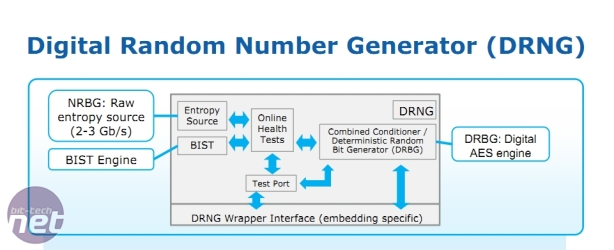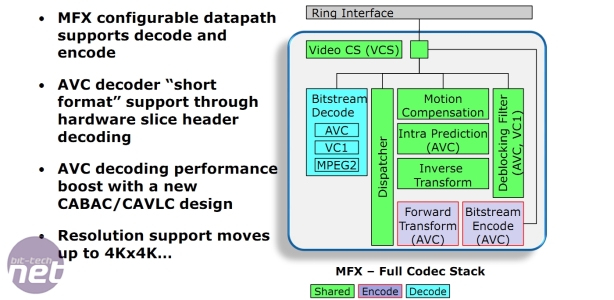
Ivy Bridge Media Upgrades and Security Features
Intel might have beefed up the stream processor (EU) count in Ivy Bridge’s Processor Graphics unit, but it continues to see fixed-function logic as the best way to handle media encoding and playback. It keeps most of the fixed-function logic in separate units, although pieces of media-specific hardware are scattered throughout the Processor Graphics design. For example, the Video Front End (VFE) unit is unsurprisingly located in the front end unit, while you’ll find a Media Sampler unit in each Slice (stream processor cluster) and a Media Pixel Ops unit in the Slice Common.Intel claims that it's increased the performance and image quality of its QuickSync media encoding technology, at least partly because there are more Slices and therefore more Media Sampler units within the design. The extra Media Sampler units definitely increase performance for what Intel calls ‘scaling’ (by which we assume Intel means ‘upscaling’) and ‘other filters'.
The multi-format codec (weirdly resulting in the ‘MFX’ acronym) has been upgraded to deliver more performance too, but Intel says it only handles MPEG-2, VC1, AVC and IVC. 'We focused on the mainstream format, which is AVC,’ the company told us. Other codecs clearly have to be shoved through the stream processors. However, the MFX can handle 4K x 4K resolutions of 4,096 x 4,096, which is overkill considering that, at a 16:9 ratio, 4K video will be 4,096 x 2,304 pixels. Even more overkill is Intel’s claim that the Media engine of Ivy Bridge ‘has sufficient performance to playback multiple 4K videos [simultaneously].’
While 4K video support is impressive, Intel hasn’t completely fixed the 24fps issue that some people noticed in Sandy Bridge. By not quite getting the frame rate of video playback for this format of video, movies can appear to stutter.
When asked about this, Dr Hong Jiang, senior principal engineer and chief media architect for Intel, said that ‘we’ve improved the clock for Ivy Bridge, so that issue is much reduced. Compared to Sandy Bridge, it’s a major step forward.’ Tom Piazza, Intel senior fellow, chipped in, adding that ‘it’s significantly reduced – you’d have to look real hard to catch it.’
New Security Features in Ivy Bridge
Intel will also implement a digital random number generator (DRNG) with Ivy Bridge; another move that should save power over the current analogue design. The random number generator in a CPU helps to create a secure link with the security of a website by creating a unique link between the site and your PC that’s very hard to snoop and piggyback. Analogue RNGs are said to be quite inefficient when it comes to power draw, however.The new DRNG is designed with standards compliance in mind, with support for ANSI X9.82, NIST SP 800-90 and NIST FIPS 140-2/3 Level 2 certifiable entropy source all cited. The random number can be 16-, 32- or 64-bit.

Intel will implement a digital random number generator, ditching the
inefficient analogue unit currently used
There’s also Supervisory Mode Execution Protection (SMEP), which Intel says will help to prevent ‘execution out of untrusted application memory while operating at a more privileged level.’ This refers to the ‘rings of security’ that we mentioned when talking about performance upgrades. The idea is that the software is run in one of four rings (or levels) of privileged access, and that you don’t want malware creeping from a less privileged ring of access into a more privileged ring, where it can really do serious harm.

MSI MPG Velox 100R Chassis Review
October 14 2021 | 15:04










Want to comment? Please log in.